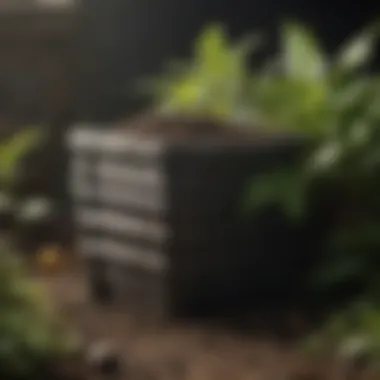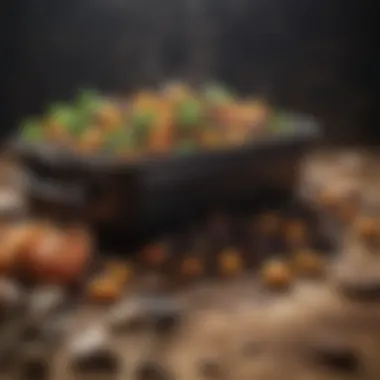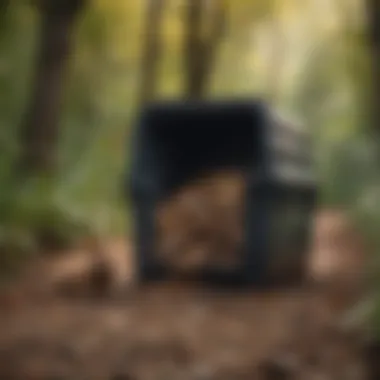Understanding What Items Should Not Be Added to Your Compost Bin


What Should Not Be Included in a Compost Bin: A Detailed Guide
Overview of the Topic
Composting is a crucial practice in promoting sustainability and reducing waste. It involves transforming organic materials into nutrient-rich soil for gardening. Understanding what should not be put in a compost bin is essential to maintain the quality and effectiveness of composting efforts.
Common Misconceptions and Correct Practices
Many people mistakenly believe that all organic matter can be composted. However, certain items can disrupt the composting process or create a harmful end product. These items include meat, dairy products, pet waste, oily foods, and diseased plants. By avoiding these materials, individuals can ensure that their compost remains healthy and beneficial for soil enrichment.
Environmental Impact and Risks
When inappropriate items are added to a compost bin, they can introduce pathogens, pests, and toxins that harm the environment. For example, pet waste can contain parasites and harmful bacteria, while meat and dairy products may attract unwanted animals. Understanding the environmental risks associated with improper composting practices underscores the importance of adhering to composting guidelines.
Best Alternatives and Disposal Methods
Instead of composting restricted items, consider environmentally-friendly disposal options. Food scraps can be processed in a food digester or sent to a local compost facility. Meat and dairy products are best suited for anaerobic digestion, a process that breaks down organic matter in the absence of oxygen. By exploring alternative disposal methods, individuals can minimize waste while protecting the integrity of their compost.
Impact on Soil Health and Ecosystems
Inappropriate composting practices not only affect soil health but also impact entire ecosystems. Toxic substances can leach into the soil, contaminating groundwater and harming plant life. By prioritizing responsible composting habits, individuals can contribute to the preservation of soil quality and the well-being of surrounding ecosystems.
Sustainable Solutions and Community Engagement
To promote effective composting practices, community engagement plays a vital role. Educating individuals on the importance of proper composting techniques and providing resources for sustainable waste management can foster a culture of environmental responsibility. By implementing sustainable solutions at a community level, the collective impact of composting initiatives can be significantly enhanced.
Introduction
In the realm of sustainability and eco-conscious living, understanding what should not go into a compost bin is paramount. This article embarks on a profound journey delving into the intricate details of composting, shedding light on the crucial aspects often overlooked. As we navigate through the labyrinth of composting no-no's, we aim to equip you, dear reader, with the knowledge necessary to steer clear of pitfalls and embrace best practices in your eco-friendly endeavors.
Composting, at its core, is a biological process that transforms organic waste into nutrient-rich soil amendment. By composting, we mimic nature's way of recycling organic matter, minimizing waste sent to landfills, and nurturing the soil. The significance of this practice extends beyond waste reduction; it embodies a sustainable approach towards cultivation, fostering a harmonious relationship between mankind and the environment. Understanding the do's and don'ts of composting is akin to mastering a skill that not only benefits us but the planet as a whole.


As we embark on this educational journey, we will illuminate the importance of segregating waste materials that are incompatible with the composting process. By identifying and comprehending what not to put in a compost bin, we pave the way for effective waste management, reduce contamination risks, and contribute positively to the ecosystem. This comprehensive guide is poised to unravel the intricacies of composting restrictions, enlightening you on the path towards sustainable living practices. Let us delve deeper into the world of composting dos and don'ts, enriching our understanding of how small actions can yield substantial environmental impacts.
Understanding Composting
Composting is a vital aspect of sustainable waste management, playing a crucial role in reducing the volume of organic waste that ends up in landfills. By breaking down organic matter into nutrient-rich soil, composting helps enrich soil quality and promote plant growth. Understanding the intricacies of composting is essential for individuals aiming to maximize the effectiveness of their composting practices. It involves recognizing the differences between aerobic and anaerobic composting processes, as well as understanding the key factors that influence the composting process.
The Basics of Composting
Why Composting is Beneficial
One of the fundamental reasons why composting is regarded as beneficial is its ability to reduce waste and minimize the environmental impact of organic materials. By transforming kitchen scraps, yard waste, and other organic matter into compost, individuals can divert significant amounts of waste from entering landfills. This not only helps in reducing methane emissions, greenhouse gases, and the need for chemical fertilizers but also enriches the soil with valuable nutrients, enhancing plant growth and soil health.
Key Components of Compost
Compost primarily consists of two main components - green materials (nitrogen-rich) and brown materials (carbon-rich). Green materials include fruit and vegetable scraps, grass clippings, and coffee grounds, while brown materials consist of dried leaves, straw, and cardboard. The combination of these components is crucial for maintaining a proper carbon-to-nitrogen ratio in the compost pile, facilitating the decomposition process and producing high-quality compost ideal for enhancing soil fertility.
Composting Process
Aerobic vs. Anaerobic Composting
Aerobic composting relies on the presence of oxygen to decompose organic matter efficiently. This method promotes the growth of aerobic bacteria that thrive in oxygen-rich environments, breaking down organic materials quickly and producing minimal odors. In contrast, anaerobic composting occurs in an oxygen-deprived environment and may result in the production of foul-smelling compounds like hydrogen sulfide.
Factors Affecting Composting
Several factors impact the composting process, including moisture levels, carbon-to-nitrogen ratio, particle size, and aeration. Maintaining the right balance of these factors is essential for ensuring optimal conditions for decomposition. Excessive moisture can lead to a lack of oxygen in the compost pile, while a high carbon-to-nitrogen ratio may slow down the decomposition process. Proper aeration, along with regular turning and monitoring, plays a crucial role in accelerating compost breakdown and producing high-quality compost for use in gardens and landscaping projects.
Items Unsuitable for Compost Bins
To comprehend the intricacies of composting effectively, one must grasp the crucial concept of items unsuitable for compost bins. This section delves deep into the pivotal reasons why certain materials cannot find a place in a compost bin. By understanding and adhering to these guidelines, individuals can avert potential issues and elevate their composting practices to new heights.
Common Household Waste
Meat and Dairy Products


Meat and dairy products stand out as primary contenders in the realm of unsuitable compost materials. Their inherent nature poses challenges to the composting process, with their slow decomposition rates and tendency to attract pests. This section scrutinizes the specific attributes of meat and dairy products that render them unfit for compost bins. Exploring these characteristics sheds light on why excluding them is paramount for optimizing compost quality and minimizing environmental risks.
Processed Foods
Within the spectrum of household waste, processed foods emerge as another category unsuitable for composting. These items, laden with preservatives and additives, disrupt the natural balance essential for successful composting. Here, we unravel the distinctive features of processed foods that make them incompatible with compost bins. By acknowledging these aspects, individuals can make informed decisions to enhance their composting endeavors and reduce their ecological footprint.
Garden and Yard Waste
Large Branches and Twigs
Large branches and twigs, despite their organic composition, present challenges when placed in compost bins. Their slow decomposition rate hinders the overall composting process and may lead to imbalances within the bin. This segment scrutinizes the key characteristics of large branches and twigs that warrant their exclusion from compost bins. Delving into this topic elucidates the rationale behind steering clear of these materials to ensure a harmonious and productive composting environment.
Weeds with Mature Seeds
Weeds carrying mature seeds pose a unique threat to composting efficiency. By introducing mature seeds into the compost bin, individuals inadvertently sow the seeds of future weed growth, potentially resulting in a persistent weed issue. Here, we delve into the distinctive features of weeds with mature seeds and highlight the repercussions of incorporating them into compost bins. Understanding these nuances empowers individuals to adopt strategic waste management practices and safeguard the integrity of their composting efforts.
Concerns and Impacts
Composting is not without its challenges, and understanding the concerns and impacts associated with improper practices is crucial for maintaining a sustainable approach. By delving into the negative effects of improper composting, individuals can make informed decisions to mitigate harm to the environment. Whether through soil contamination or odor issues, these aspects play a significant role in shaping the overall effectiveness of composting systems. Identifying and addressing these concerns is paramount for individuals looking to contribute positively to environmental conservation.
Negative Effects of Improper Composting
Soil Contamination
Soil contamination is a pressing issue that arises from improper composting methods. When materials unsuitable for compost bins, such as chemically treated products or contaminated waste, are included in compost piles, they can introduce harmful substances into the soil. This can have adverse effects on plant growth, water quality, and overall ecosystem health. Such contaminants can persist in the environment for prolonged periods, posing a threat to both terrestrial and aquatic life. Proper waste segregation and adherence to composting guidelines are essential in preventing soil contamination and promoting ecological balance.
Odor Issues
Odor problems resulting from improper composting practices can not only be unpleasant but also indicative of underlying issues. When organic materials decompose anaerobically due to poor aeration or excessive moisture levels, it leads to the production of foul-smelling gases like hydrogen sulfide and ammonia. These odors not only affect nearby residents but also signal inefficiencies in the composting process. By addressing aeration techniques, moisture levels, and proper layering of materials, individuals can minimize odor concerns and enhance composting efficacy.
Environmental Impact


Potential Harm to Wildlife
The potential harm to wildlife is a critical consideration when evaluating the environmental impact of improper composting. Inadequately managed compost piles can attract pests and unwanted wildlife, disrupting local ecosystems and endangering native species. Rodents, insects, and other animals drawn to decomposing organic matter may cause damage to crops, transmit diseases, or alter the natural balance of fauna in the area. Implementing secure composting methods, organic pest deterrents, and regular monitoring can help mitigate the risk of harm to wildlife populations.
Greenhouse Gas Emissions
Greenhouse gas emissions resulting from improper composting practices contribute to climate change and environmental degradation. When organic matter decomposes without sufficient oxygen, it produces methane, a potent greenhouse gas that traps heat in the atmosphere. Additionally, the transportation and handling of compost materials can generate carbon dioxide emissions, further exacerbating the carbon footprint associated with composting. Utilizing aerobic composting techniques, minimizing transport distances, and cultivating awareness of greenhouse gas emissions are essential steps in reducing the environmental impact of composting activities.
Best Practices and Alternatives
Composting is a crucial aspect of sustainable waste management, and understanding the best practices and alternatives is essential for optimizing composting processes. By focusing on specific elements like proper disposal methods, individuals can significantly reduce their environmental footprint. Incorporating composting alternatives is paramount in achieving efficient waste reduction objectives while minimizing negative impacts on the environment. When considering alternatives, individuals must weigh the benefits such as increased nutrient-rich soil production against potential challenges like longer decomposition periods.
Proper Disposal Methods
Composting Alternatives
Composting alternatives play a pivotal role in waste management strategies, offering a unique approach to processing organic materials. One key characteristic of composting alternatives is their versatility in accommodating various types of organic waste, from kitchen scraps to yard clippings. This flexibility makes composting alternatives a popular choice for eco-conscious individuals looking to diversify their sustainability efforts. While these alternatives provide an efficient means of organic waste management, they may require specialized equipment or settings, posing potential disadvantages in terms of accessibility and initial costs.
Recycling Guidelines
Recycling guidelines complement composting practices by providing additional insight into sustainable waste disposal methods. The key characteristic of recycling guidelines lies in their focus on reusing materials to minimize environmental impact. By following these guidelines, individuals can help reduce the volume of waste destined for landfills and conserve valuable resources. One unique feature of recycling guidelines is their emphasis on sorting waste into distinct categories for proper processing, ensuring maximum efficiency in resource recovery. However, adherence to recycling guidelines may pose challenges in terms of public awareness and infrastructure support, limiting widespread adoption.
Tips for Effective Composting
Balancing Green and Brown Materials
Achieving the right balance between green (nitrogen-rich) and brown (carbon-rich) materials is essential for successful composting. The key characteristic of balancing green and brown materials lies in creating a harmonious environment for microbial activity and decomposition. This balance ensures optimal conditions for the breakdown of organic matter, leading to nutrient-rich compost. One unique feature of this practice is its role in offsetting odors and accelerating the composting process. However, maintaining this balance may require continuous adjustments based on the composition of organic waste, posing a challenge for beginners in composting.
Aeration Techniques
Aeration techniques play a critical role in promoting oxygen flow within the compost pile, facilitating aerobic decomposition processes. The key characteristic of aeration techniques is their ability to prevent anaerobic conditions, which can lead to foul odors and slow composting. By incorporating regular turning or stirring of the compost pile, individuals can enhance microbial activity and nutrient breakdown. One unique feature of aeration techniques is their contribution to maintaining optimal moisture levels, crucial for microbial survival and decomposition efficiency. Nonetheless, implementing consistent aeration practices may demand physical effort and time dedication, requiring careful consideration for individuals seeking to streamline their composting routines.
Conclusion
Composting is a fundamental practice in sustainable living, and understanding what not to put in a compost bin is crucial for its success. In this comprehensive guide, we have explored the various materials that should be avoided in a compost bin to ensure optimal composting results and prevent potential complications. By highlighting the importance of proper waste management and composting practices, this article aims to equip individuals with the knowledge needed to make informed and eco-conscious decisions.
One of the key elements emphasized throughout this guide is the impact of improper composting on the environment and soil health. By refraining from adding unsuitable items such as meat, dairy products, and processed foods to compost bins, individuals can help mitigate soil contamination and reduce odor issues. Additionally, incorporating best practices like balancing green and brown materials and employing proper aeration techniques can enhance the composting process and yield nutrient-rich compost for gardening and landscaping purposes.
Moreover, considering the environmental repercussions of improper composting, including potential harm to wildlife and greenhouse gas emissions, it becomes evident why conscious waste management is vital. By following the insights provided in this guide and adopting sustainable disposal methods, individuals can contribute to environmental preservation and minimize their carbon footprint.



